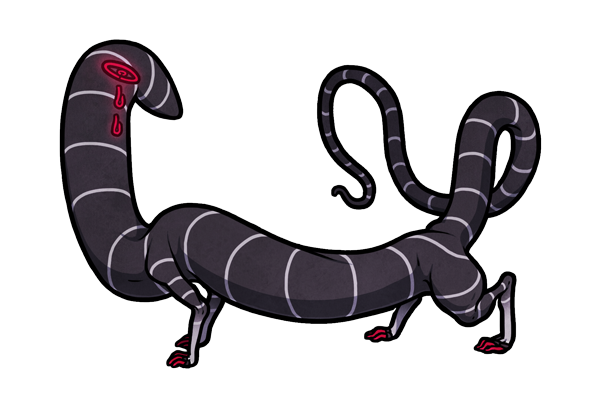

neoridrozi
the voyeurs
prefix neori suffix drozi
ocelo feranturus
physical appearance
The neoridrozi /ˈniɔɹədɹəʊzi/ is a black, thin-striped stranger with eye and teardrop markings made of neon lights. These glass-like structures are embedded in the side of the stranger's head, and vary in color between individuals. Though these markings are hard and flexible to the touch, the tubes warp in shape as the neoridrozi moves, which prevents them from being shattered. The eyes themselves remain illuminated at most times; the neoridrozi's teardrops, however, light up only under certain circumstances. Smashing the eyes causes the neoridrozi to grow more clumsy and sluggish, though the stranger does not appear⼆ to be fully blinded by such an injury.
The neoridrozi's delicate, human-like skin forms only a thin layer above its black inner flesh. Though the skin and flesh itself are easy to cut, the neoridrozi's inner sinews are interspersed with bundles of tendon-like strings that resist slicing via all but the sharpest of blades. When exposed to air, the neoridrozi's "muscles" ooze a brackish fluid that stings both the skin it comes in contact with, as well as any other part of the body that the subsequent rash touches.
Possessing little recuperative vigor, the neoridrozi is able to recover from injury only when in a dormant state, during which time its eyes remain unlit. Even shallow cuts, however, require several days of dormancy to heal. Thus, many neoridrozi do not seem to make any attempt to recover from minor or superficial injuries, and older individuals can often be identified by small rips or scuff-marks between the fingers, or at the tip of the nose or tail. In addition, no length of dormancy allows the neoridrozi to heal broken or burnt-out eyes.
The neoridrozi's body carries with it no odor, and the strain is silent, outside of a faint but ever-present electric buzz.
the humming of an electrical circuit.

behaviour and effects
The neoridrozi possesses a dispassionate but attentive disposition. It is exclusively nocturnal, and keeps a large and ring-shaped territory, which it patrols in alternating clockwise and counterclockwise rounds. It slinks across awnings and scaffolds with a seductive unease, avoiding the ground whenever possible, and angling its head and neck so that its neon eyes can light its way.
As the stranger moves past the neon and incandescent lights that line its path, its presences causes the bulbs to either flicker, or grow brighter. These lights only rarely break or burn out, and do so exclusively around either very young, or very old individuals.
The light of the neoridrozi's eyes captivates small insects, which the stranger plucks from the air with precise reflexes (catching the insect in 99.6% of attempts). It crushes these pests without hesitation, and does not wipe the remains from its claws.
interactions between individuals
When two neoridrozi meet, they first observe one another from a distance of a half-block or more, before both move in opposite directions. The stranger seems to retain awareness of the present whereabouts of any neoridrozi that it has previously encountered, and uses this information to adjust their own territory as needed. As such, over time, neoridrozi infestations become evenly distributed throughout a city.
interactions with sensitives
Under normal circumstances, the neoridrozi is not explicitly curious about sensitives. Although it may pause for a moment to tilt its head or make a sign-like gesture with its hands, interaction is not pursued, and the neoridrozi returns to its wander within minutes. When touched aggressively, the neoridrozi discharges a small amount of electricity, though the level amounts to little more than a stinging buzz. Otherwise, it possesses no defensive abilities or behaviours. It attempts to escape violence by climbing to safety or slipping into shelter, and it is only when cornered that it visibly reacts to pain by writhing and shuddering.
The neoridrozi sheds its ambivalence only in the case of crying sensitives, which it regards as fascinatingᏪ above all else. It always moves towards any crying individual within its territory, and upon reaching the sorrowful individual, its interest does not spontaneously wane. Once an encounter has begun, the neoridrozi either stands at rest (particularly when granted a suitable perch) or circles at a distance of no more than the sensitive's height, its tear markings lighting up𐑙 in sequence as it does so. The strain does not attempt physical interaction, however, and moves away if approached.
Should the sensitive continue crying for more than three minutes and forty five seconds, the neoridrozi uses its claw to scratch a tally mark (or tally marks) onto any nearby surface, with the number of tallies corresponding to the number of crying sensitives it has encountered.丯
丯 The first one had seen twenty, and so it made twenty marks. The second one made only five marks. The third one filled the wall...
Once this tally mark has been drawn, the neoridrozi's effect sets in. The strain's influence causes the act of crying to feel both physically and emotionally pleasurable, if not euphoric. This gratification does not supersede any mental or bodily pain, but instead, is felt in addition to existing sensations. Only sincere୭ crying becomes gratifying – mock tears cannot be relished.
interactions with corpses
The neoridrozi's eyes glow less brightly around human carcasses, with the presence of more than six hundred and fifty dead bodies causing its eyes to go out altogether (though this state remains temporary). While its eyes are "corpse-dimmed", the neoridrozi does not seek out crying individuals, and instead tends to remain in place. It displays no prolonged interest towards the corpses themselves, besides an occasional furtive touch towards the eyes; rather, the stranger seems bored,㇊ as though forced to wait.㇇
㇊ Tapping each finger, count the coins on the ground, I watch the clouds pass by above.
Gerard Hallidan. "Washout".
㇇ "And wait it does, till they don't look like people no more;
that's how you know it's been too long since we've said hello..."
Gerard Hallidan. "Washout", (erased lyrics).
aging and death
Most neoridrozi die from wear-and-tear long before they reach the end of their natural lifespan, with their bodies breaking down due to the numerous cumulative, unhealed rips to the skin and sinews. The rare neoridrozi that reaches the end of its natural lifespan halts all action abruptly, its low buzzing intensifying to a ringing drone. The stranger first smashes one eye, and then the other, dying the instant that the second is broken.
Whether the neoridrozi dies of its own volition or not, its body collapses to the ground with a thud. As the corpse degrades, it exudes the smell of both rubber and rotting meat – rather than putrefy in an organic manner, however, the neoridrozi's tissues grow plasticine and brittle, until they splinter apart to nothing after two to five days. Only its eye markings remain, although these relics become too fragile to handle without shattering them into unseen grains.
A neoridrozi who witnesses another neoridrozi's death allows their tears to flicker in sympathy𐐈 for several minutes, before the survivor draws a single tally line and continues on its way.



